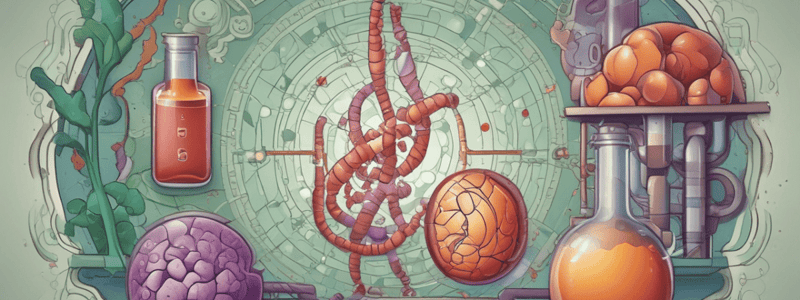Podcast
Questions and Answers
What is the main function of enzymes in biological systems?
What is the main function of enzymes in biological systems?
- To convert products back to substrates
- To accelerate specific chemical reactions (correct)
- To slow down chemical reactions
- To consume substrates
What is the term for the molecule that an enzyme acts on?
What is the term for the molecule that an enzyme acts on?
- Holoenzyme
- Cofactor
- Product
- Substrate (correct)
What is the term for an enzyme without its nonprotein component?
What is the term for an enzyme without its nonprotein component?
- Cofactor
- Metallo-enzyme
- Holoenzyme
- Apoenzyme (correct)
What is the term for a nonprotein moiety, such as a metal ion, that is required for enzyme activity?
What is the term for a nonprotein moiety, such as a metal ion, that is required for enzyme activity?
Which of the following enzymes requires Zn2+ for its activity?
Which of the following enzymes requires Zn2+ for its activity?
What is the term for an enzyme that requires a metal ion for its activity?
What is the term for an enzyme that requires a metal ion for its activity?
What is the role of a coenzyme in an enzymatic reaction?
What is the role of a coenzyme in an enzymatic reaction?
What is the function of a proenzyme?
What is the function of a proenzyme?
What is the energy barrier that separates reactants and products in a chemical reaction?
What is the energy barrier that separates reactants and products in a chemical reaction?
How do enzymes lower the energy required for activation?
How do enzymes lower the energy required for activation?
What is the purpose of the EC numbering system for enzymes?
What is the purpose of the EC numbering system for enzymes?
Which class of enzymes catalyzes the oxidation of one substrate with simultaneous reduction of another substrate?
Which class of enzymes catalyzes the oxidation of one substrate with simultaneous reduction of another substrate?
Which enzyme is an example of a transferase?
Which enzyme is an example of a transferase?
What is the result of the action of a hydrolase enzyme?
What is the result of the action of a hydrolase enzyme?
What is the primary function of Lyases enzymes?
What is the primary function of Lyases enzymes?
What is the enzyme that catalyzes the breakdown of Acetylcholine into Choline and acetate?
What is the enzyme that catalyzes the breakdown of Acetylcholine into Choline and acetate?
Which class of enzymes is responsible for producing optical, geometric or positional isomers of substrates?
Which class of enzymes is responsible for producing optical, geometric or positional isomers of substrates?
What is the reaction catalyzed by Aldolase enzyme?
What is the reaction catalyzed by Aldolase enzyme?
Which class of enzymes is responsible for linking two substrates together, usually with the simultaneous hydrolysis of ATP?
Which class of enzymes is responsible for linking two substrates together, usually with the simultaneous hydrolysis of ATP?
What is the enzyme that catalyzes the reaction: Glyceraldehyde-3-phosphate → Dihydroxy acetone phosphate?
What is the enzyme that catalyzes the reaction: Glyceraldehyde-3-phosphate → Dihydroxy acetone phosphate?
Flashcards are hidden until you start studying
Study Notes
Enzymes
- Enzymes are biological catalysts produced by living tissues, which accelerate specific chemical reactions without being consumed in the process.
- Most enzymes are proteins, except for a small group of RNA molecules that act as ribozymes.
Substrate, Product, Cofactor, and Coenzyme
- Substrate: the molecule that an enzyme acts on
- Product: the molecule that an enzyme converts the substrate into
- Cofactor: a non-protein moiety that can be a metal ion (e.g., Zn2+ or Fe2+) or a small organic molecule
- Coenzyme: a non-protein moiety that is a small organic molecule
- Holoenzyme: the active enzyme with its non-protein component (cofactor or coenzyme)
- Apoenzyme: the enzyme without its non-protein moiety, which is inactive
Types of Cofactors and Coenzymes
- Metallo-enzymes: enzymes that require certain metal ions for their activity (e.g., zinc for Carbonic anhydrase and iron for Cytochrome oxidase)
- Cosubstrate: a coenzyme that only transiently associates with the enzyme and dissociates from the enzyme in an altered state (e.g., NAD+)
- Prosthetic group: a coenzyme that is permanently associated with the enzyme (e.g., FAD)
Proenzymes (Zymogens)
- Inactive enzymes found in the blood or digestive tract, which become activated by other enzymes (e.g., chymotrypsinogen is activated by trypsin to form chymotrypsin)
Mechanism of Enzyme Action
- Enzymes lower the energy required for activation to the transition state, allowing chemical reactions to occur at normal physiological temperatures
Nomenclature of Enzymes
- The International Union of Biochemistry and Molecular Biology (IUBMB) suggests a system of nomenclature for enzymes, with a name starting with EC (enzyme class) followed by 4 digits (e.g., EC.1.1.1.1)
Classification of Enzymes
- Class 1: Oxidoreductases (e.g., Lactate dehydrogenase)
- Class 2: Transferases (e.g., Hexokinase)
- Class 3: Hydrolases (e.g., Acetylcholine esterase)
- Class 4: Lyases (e.g., Aldolase)
- Class 5: Isomerases (e.g., Triose phosphate isomerase)
- Class 6: Ligases (e.g., Acetyl CoA carboxylase)
Studying That Suits You
Use AI to generate personalized quizzes and flashcards to suit your learning preferences.



